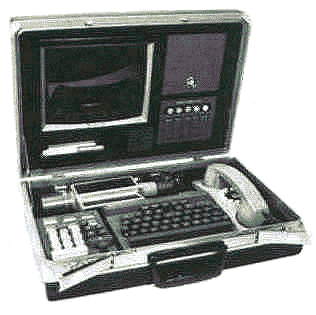
The year 2001 has become famous as the title of a science fiction film of Stanley
Kubrick. It is also the only film, for which one of the most important directors
in movie history was awarded an Oscar (for special effects). The film, made
in 1969, tells the story of the search for a black obelisk that seems to have
influence on the history of mankind itself.Near the beginning of the movie,
we see the "dance" of a space station. It may be noted that such a
space station will become a reality in 2001. The first crew of the I.S.S. has
already entered the spaceship, and will stay there for a couple of months. On
the other hand, travelling to Jupiter, as in the movie "2001 - A space
odyssey", is far from being done. We can go further: the movie presents
the idea of a portable computer, and also the concept of a computer going mad
(HAL), threatening the life of the spaceship crew. Just fiction?

"Briefcase-PC" from movie "2001"
You can take a look onto other fictions as well. The creators of "Star
Trek" have enriched us with things like warp engine, beaming, and even
anticipated a planet at distant star Epsilon Eridanus. In fact, once a technology
of teleportation will be developped, using it will be named "beaming,"
for sure.
The question is: are we prepared to put such concepts to reality, if it comes
up to computer science? Look at the screenshots of the movie "The 5th Element."
This is a very interesting scene, illustrating the contradiction between autonomuous
and controlled systems.
The bad guy in the movie, named Jean-Baptiste Emmanuel Zorg, wants to demonstrate
the affordability of the new technical developments of his company to priest
Cornelius. For doing so, Zorg lets drop a glass with a drink, and the glass
smashes on the floor. In a moment, this "event" is noted by some robots,
which immediately starts to operate. They remove the garbage, clean up the carpet,
and they also discover the original state of the broken object. At the end,
Zorg becomes a copy of his glass put back into his hand and filled with the
same drink as the one what was in it before the glass smashed.
So, this is an opus on sensing technology. Considering our ideas on soft computing,
we seem to have everything what is needed already in our hands. Soft computing
ought to be the right frame for such "interior designs."
(click on the YinYang to see Lesson 2)